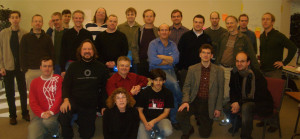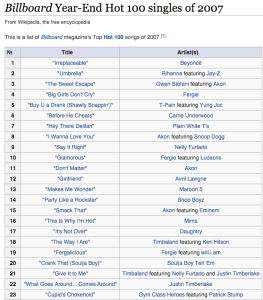
A personal music device as of Dec. 2007, when the Open Gov Data principles were outlined: opengovdata.org
It’s 2016, and we’re still missing a huge amount of open infrastructure for civic engagement.
In my nine years of experience, here are the three major areas of need in the U.S. #opengov space.
Below I’ll make the argument why this infrastructure should be provided by non-profit organizations with an institutional commitment to truly open public data.
1. Open data for every U.S. elected official and government entity
a) Available both in bulk and via an open API
b) Down to the city government and local levels
2. Open data standards for communicating with government entities
a) Like 311, standards can deliver issues into government as structured data, towards an official resolution
b) Acknowledged receipt of petitions, public legislative initiatives, questions, expertise, volunteer offers, and more
3. Open CRM’s for tracking constituent communications
a) Free & open-source software for municipal governments that intakes open data standards and transparently addresses public issues, with helpful context to get more people involved
b) Making possible visualizations and analysis of public priorities for a continual conversation with government

Dec. 2007 meeting on Principles of OpenGovData – “I was there”, but not in this photo. Attendees listed at bottom of opengovdata.org
On the first topic – open data (in bulk & via API) for every U.S. elected official and candidate – incredibly, the goal of DemocracyMap still doesn’t exist. Even though the open-data community outlined the principles of #opengovdata back in Dec. 2007. It’s badly needed — in practice, because any developer creating an app for local engagement instantly hits the hurdle of needing to populate the app with, or connect users to, current elected officials in government.
But for nearly every U.S. city, there exists no contemporary open data on local elected officials, and without shared data standards, an engagement app wouldn’t necessarily work in a town next door. Without this data, an app’s new alert features can’t easily scale through more of the 20,000 U.S. municipalities. A conversation I had just last year with a longtime tech expert in this space began, “your device should come pre-loaded with your chain of government”, and this is only possible with up-to-date bulk open data for local representatives. Connecting new app users to, say, up-to-date info on their city council members by their street address or geolocation is needed as well, and this requires a robust API. In 2016, we still don’t know what creative or popular government watchdogging apps – say, on money in politics – would have been created by game developers or web designers if it weren’t so hard to get local data.
Let’s put this scope of non-profit work into more real-world context. One goal would be to liberate open data for governments in the top 50 U.S. cities by population, covering approximately 50 million Americans, around 15% of the U.S. population. (Surrounding metropolitan areas could join in by adopting the Open Civic Data standard and the open-data community.) That would be, by population, New York City at number one, down through Wichita & New Orleans at 49 and 50. Beyond that, a medium-term goal would be covering current elected officials for the 81% of U.S. population that lives in the top 500 “urban areas” (per 2010 U.S. Census) goal of 90% coverage with at least 90% accuracy would be admirable too, towards full national coverage of course.
It’s been our non-profit’s goal since 2010 and before to make this open data available on our open-source web app OpenGovernment.org – for comprehensive transparency up and down the chain of government, federal to state to county to city to local. Think of it as a new Open Civic Data API (deprecated) – we propose a resuscitated OpenGovernment API for local elected officials. Not only covering more jurisdictions with scraped & standardized data, for new apps to remix, but also encouraging government entities themselves to publish in compliance with the Open Civic Data standard, to spread its use to county & state levels of government. Our work continues, as of now, city by city, with the open-source, open-data Councilmatic project (with partners at DataMade).
More details on scope-of-work experience – the Open States Project covered all electeds & legislative info in fifty states with around 200 volunteer contributors and a team of around two developers, plus a full-time sysadmin. 500 urban jurisdictions is 10x more, but with the amount of work already invested in the OCD standard, a similar amount of volunteers could crowdsource data up to two full-time developers and one sysadmin – this would achieve open-data for every U.S. urban area, for brand new apps & uses.
Covering over 80% of U.S. population with reliable open data on their representatives could be delivered with a charitable grant to our 501(c)3 non-profit org. This data could be re-used by non-profits, for-profits, community groups, civic startups, new developers yet-unheard-of – anyone who’s currently consuming the much-needed Google Civic Information API or the Open States API. We’d offer open data to the Google Civic API as well, but PPF would make it fully available as a bulk download & API from OpenGovernment.org. Contact me for more info on the technical requirements & roadmap to making this happen with our non-profit – I’d like to emphasize that the cost of having one non-profit maintain this data is likely less than the cost of having commercial petition sites, issue-group CRM’s and industry lobbyists maintain it on a closed code & data basis.
Number two – open data standards for constituent communications – is needed to close the feedback loop of civic engagement. “Nearly everything can be like a 311 issue!”
By which I mean – a fundamental questions remains with civic apps: why should more / new users participate, given a petition signature goes into a black hole of an overworked office in our representative democracy? As an incentive to take civic action, the public needs to know their message was received and will at least be addressed, and governments need to know how their constituents want their time prioritized. Millions of online petition signatures every day are being faxed into a Senate recycling bin or sold to advocacy groups in list-building, lead-generation services. Over the past two years, we’ve proposed a fundamentally different, open solution: confirming message delivery, closing the feedback loop with a public response. It just needs a funding champion willing to invest in shared infrastructure.
Starting from first principles, such an open standard for constituent communication needs to be maintained by an institution with community accountability, so either a proven non-profit (such as PPF) or a new tech co-op (as has been proposed) – but it shouldn’t be owned by any for-profit company, even if it’s offered at affordable rates, because it’s a shared public good and can’t be controlled or changed without sufficient consensus & due process. No one company, not even a social benefit corporation, should be able to monopolize control of the delivery of public emails – say, supporting net neutrality to members of Congress. For-profit companies can still offer tons of value & features on top of this open standard, to help their members communicate with government (e.g. commercial petition sites), but right now there’s a continuing arms race for petition delivery into entities such as Congress and NYC City Hall. Leveling the playing field is necessary for the non-profit and startup products that seek to fairly deliver public ideas alongside massive political CRM’s (such as Blue State Digital) and multi-million-dollar petition companies (such as Change) and national political groups (such as MoveOn). In fact, in Europe, two public charities conduct much of this work – mySociety in the UK (e.g., WriteToThem) and Parliament Watch (Germany) – but in the U.S., it’s been largely commercialized.
Crucially, a simple & proven open data standard already exists for this type of communication – in fact, Daniel Bennett of D.C. based Citizen Contact pioneered one with a U.S. Senate office years ago, and with PPF, we still have a working XML spec that seeks funding support and government partners. The XML file can be delivered as an attachment over email, via API, or even through a validated web page that’s linked from a social media post – turning Tweets into petition signatures, for example, and turning Facebook campaigns into open structured data.
Making social media more grab-able would have the massive benefit of harnessing diffuse chatter into open structured data for real reforms & advancing legislation. With open standards, any coalition of websites (celebrity gossip, fantasy sports, movie fans, baby bloggers) can engage in proposition development and mobilize a massive amount of supporters to keep the issue moving forward. Jurisdictions such as county governments and city council districts can intake more public comment without needing to get it just on one feedback platform or SMS outreach program – anything connected to the web can deliver a message into government entity, towards a resolution, with filters & batching & tagging & ranking to make them more intelligible of course.
The trend is already in the direction of being able to communicate in bulk with the U.S. Congress, just not in a publicly-known or open-data way. The U.S. House unveiled its private, under-publicized API for digital messages about two years ago, and to the best of my knowledge, around one-third of House offices currently support it to intake constituent letters (e.g. petition signatures). This under-the-radar API – with no public-facing webpage – should grow to include more than half of House offices sometime soon, eventually creeping over to the recalcitrant Senate. To advocates of open communication, this should mean there’s work to do to support open standards – the kind of work that PPF pioneered with our Contact-Congress project on OpenCongress in July 2011. Once established at the federal level, our open data standard for constituent communications can be used down by state & city levels of government to intake messages like 311 issues. Again, much of this hasn’t yet been advertised publicly – do many advocacy-group or campaign customers of major CRM vendors know that the House API is growing in adoption?

The San Antonio Spurs won the 2007 NBA Finals, their fourth, sweeping the Cavs in four. I’d like to add, Go Milwaukee Bucks.
The third major area, open CRM software, is needed because of the potential for discovery, reform & prioritization of issues in the political process. Open standards make new write-your-rep tools possible from plugins on news articles and blog posts. Open standards turn write-your-rep and social media posts with political actions into official government communications, in open structured data for analysis & visualization. And the data can finally create an open “org chart” for government, so constituent communications are routed correctly – to judicial, executive, or legislative branches, to county or state government offices, to the best-known CRM for that public issue. As a non-profit sustainability strategy, vending open-data-driven CRM software as a service to city & county governments presents a major revenue stream – and PPF already knows the existing open-source software that can be adapted for this purpose. The goal would be to create the #opengov expectation that the smartest city government’s don’t just have open data portals, but rather, use an open public CRM, and involve their residents in allocating budget and prioritizing the legislative schedule.
There are at least fourteen (!!) commercial ventures that seek to intake, deliver & (to varying extents) visualize public votes aye/nay on propositions/bills (PopVox, Brigade, Countable, IssueVoter, Civic Eagle, BuildQuorum, PlaceAVote, WeVote, Capitol Bells, iVocate, iCitizen, Advocate.io, DailyClout, CriticalMath, Pol.is and formerly Change Politics and Simpolfy), not to mention non-profits with somewhat-ballpark-bill-voting functions (not solely) such as (old-school) Liquid Feedback, DemocracyOS, EFF’s Democracy.io, Loomio and more apps-in-ongoing-development.
It stands to reason that these commercial players and more will come into the field as more open data on city legislation becomes available, primarily from our non-profit and smaller civic tech companies – I’m placing a marker down for the argument that a share of their development resources should go to support the open-data infrastructure. As open data evangelists first and foremost, the Congress-data-provider network didn’t exactly band together to secure baseline level of community support from all the consumers of federal bill data – largely, for a while, it was going to be supported by major transparency non-profits in D.C. – but the landscape has changed since ’11 and before.
Open data for everything in U.S. government – for new developers to build creative, popular alert services & participation platforms – was always where we were headed with our non-profit OpenGovernment project in 2011, before we ran into funding issues. The need is still there, clearly, given the twelve consumers above. PPF has the right incentives and public-benefit structure to support amazing new work from this downloadable, queryable, up-to-date data on everyone who represents us. Please get in touch to discuss options towards supporting the longtime dream of DemocracyMap, a community open-data store.
My intentionally-provocative proposal here is the “1% Open Tech Rule” — that civic tech nonprofits or open-source projects should receive at least 1% of the venture-capital funding of their commercial equivalents, to keep the field slightly competitive and provide open-source & open-data alternatives.
- So a Dec. 2014 round of $25m to Change would entail $250,000 to AskThem for open data on candidates & elected officials, and p2p connections between users (not just advocacy orgs.) on local questions & national issues;
- A May 2014 round of $15m to OpenGov.com would entail $150,000 to Open Budget Oakland‘s open code, with locally-connected explanations of the budget process and ways to get involved (not just top-line visualizations);
- Sept. 2014 round of $17m to Mindmixer/mySidewalk would be $170,000 to Shareabouts, for open-source mapping & suggestions in a user-friendly interface, deepening local ties with place-based community planners;
- March 2015 round of $110m to NextDoor would be, well, a reasonable amount for an open-source neighborhood discussion site – say, Discourse, or OpenPlans tools.
It would be an astonishing development for the non-profit field if even a $1m fund was set up with grants along the lines above, allocated quarterly by an Advisory Board of civic tech figures, to keep open-source & open-data & open-standards tech alternatives up and running. This is wildly imaginary, but hopefully offers a valuable corrective tendency for shareable infrastructure in the civic tech landscape, towards a networked public sphere. How about it – half a million from one foundation, half a million from another funder, awarded something like the NewsChallenge for open standards projects?
Next year, our non-profit PPF will mark its tenth year in open government data and civic engagement web development. We’re in position to see through the promise of open data for every level of government, down to local, and I hope we have the opportunity. Please help our 501c3 non-profit organization obtain a charitable grant to build these shared public resources. We have the domain experience & longtime partnerships to tackle them, but no core funding support – our entire 2015 budget was just $75,000, about two percent of the annual budget of civic tech non-profits in our field (!!), which are in turn only half of the highest-capitalized for-profit companies in the field. Email me: david at ppolitics.org, and feel free to spread the word & respond on the Twttr commercial micropublishing service.
Previously, on PPF Blog: what’s needed for civic engagement follow-up (11-14-14), “X11” open data spec, open constituent communications & open CRM (5-1-14), unpacking “civic tech” (4-4-15).


Pingback: The Future of Civic Tech | Civic Innovations